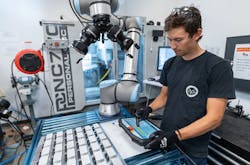Collaborative robots (cobots) are designed to work alongside humans in a safe manner. Their use in industry over the past 10+ years has proven their ability to be used safely. But just like any other piece of machinery, safety can be subject to a number of factors.
To learn more about assessing the safety of cobots, we connected with Devin Murray of Schmersal, a supplier of safety switch gear devices and systems for personnel and machine protection, for a recent episode of the Automation World Gets Your Questions Answered podcast.
Murray said that, beyond the built-in safety aspects of cobots—such as smooth, rounded edges to minimize pinch points, slow operating speeds and lighter load capacities—key safety regulations have been introduced to help ensure a safe working environment. “In 2012, the standard which defined safety requirements for industrial robots—ISO 10218—was harmonized to the North American ANSI/RIA 15.06 standard and referenced collaborative robots,” he said. “Then in 2016, the technical standard ISO/TS15066 was released to provide further guidance on safe implementation of collaborative robot applications.”
These standards brought risk assessment directives to cobots. “ISO/TS15066 clearly calls out that a risk assessment is necessary to identify the hazards and risks associated with a collaborative robot system application. It notes that the integrator ‘shall conduct a risk assessment as described by ISO 10218 and ANSI/RIA15.06’.”
Despite these standards, Murray said that cobot risk assessments are commonly overlooked in industry. “Typical application hazards, such as impact questions, trapping and projectiles are often overlooked once the term collaborative robot is used because it’s taken that this is a safe piece of equipment. But this is why a risk assessment is required. So you have to look at the loads, the materials and the robot torque,” he noted.
Murray said one of the biggest problems he sees in cobot risk assessments is related to the cobot’s location. Based on where the cobot is located, you have to consider if you are “creating a crushing or a trapping hazard with the cobot. You also have to consider if the cobot position is high enough that it could come into contact with an operator’s head—which is not allowed at all.”
4 methods of safe cobot operation
ISO/TS15066 defines four methods of collaborative operation:
- Safe-rated monitored stop—where the cobot motion is stopped while the operator is within the collaborative workspace.
- Hand guiding—the motion of the collaborative robot is controlled completely by the operator, which can be during waypoint-based teaching where the operator is physically showing the robot or programming the robot for a defined motion or path.
- Speed and separation monitoring—as a human approaches the cobot, it will decrease its speed to a slower safe pace. And once the operator enters that defined protective separation distance, the cobot will enter into a protective stop.
- Pressure and force limiting—in instances where it has been identified that there will be contact with the cobot and operator, either by accident or on purpose, the cobot pressure and force must be limited so that it will not exceed the allowable thresholds defined by the standard.
Murray explained that ISO/TS15066 looks at different regions of the human body and lists the maximum pressures and forces allowed that can be experienced by the operator and which the cobot cannot exceed.
The bottom line for cobot safety is to: 1) Not assume it will always be safe to use alongside humans just because it’s a cobot; and 2) Identify the hazards and risks associated with your planned use of the cobot using the available safety standards.
“Cobot safety standards, are just like any machine safety standard,” said Murray. “But what makes it unique, and perhaps slightly more difficult to achieve is the fact that contact with the cobot can be expected and accepted—which is different than most other safety standards where the main goal is to guard against contact at the point of operation. So, yes, risk assessments of cobots can be more difficult, but they are definitely achievable.”

